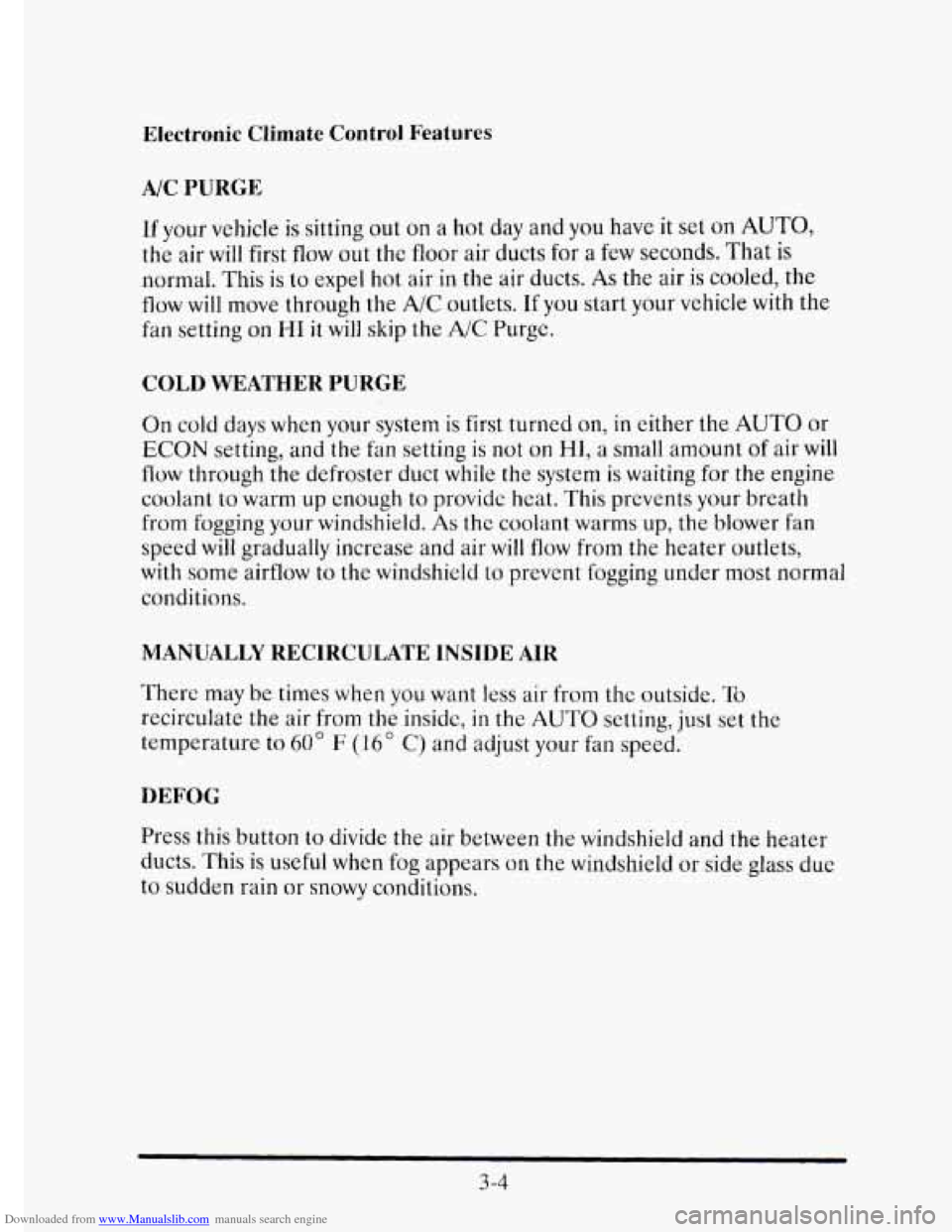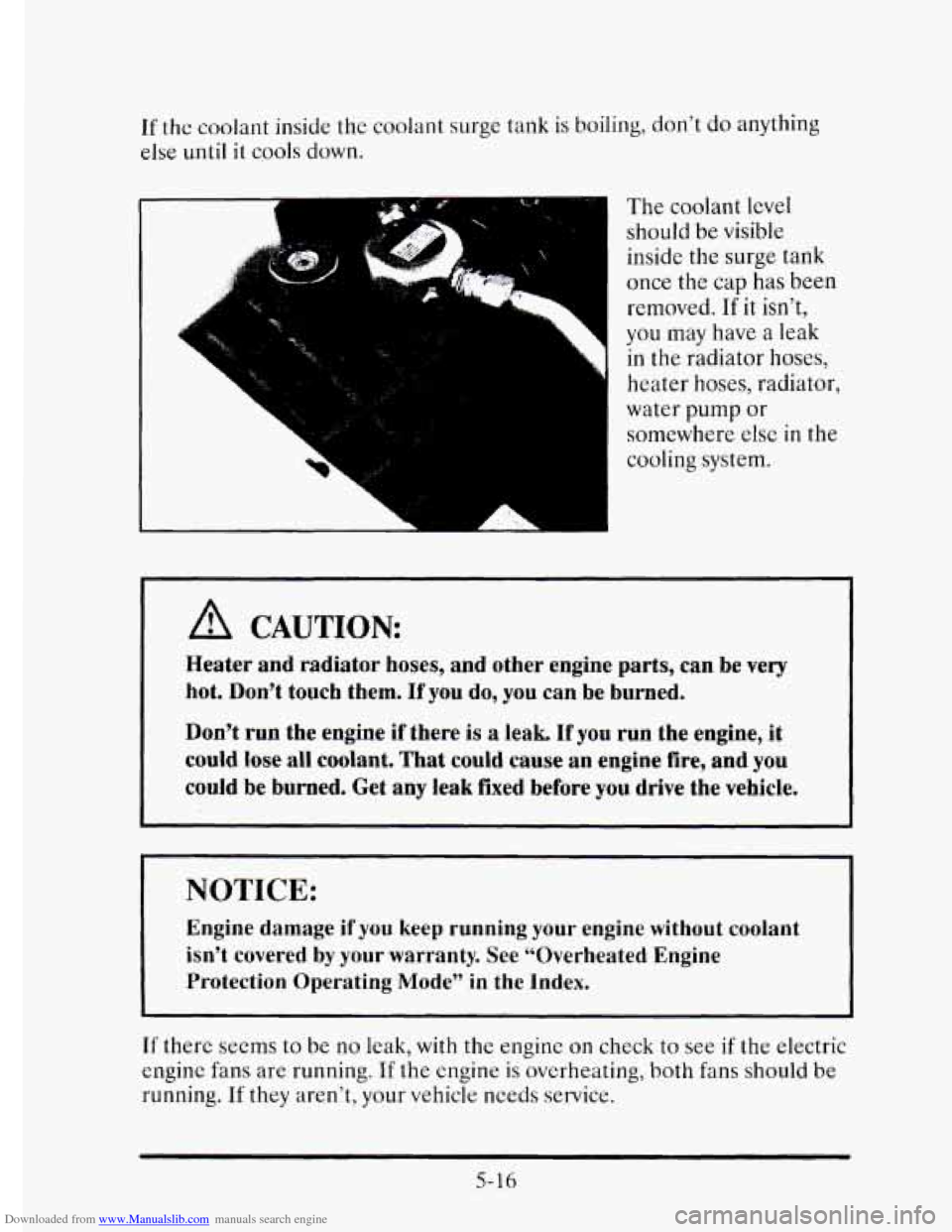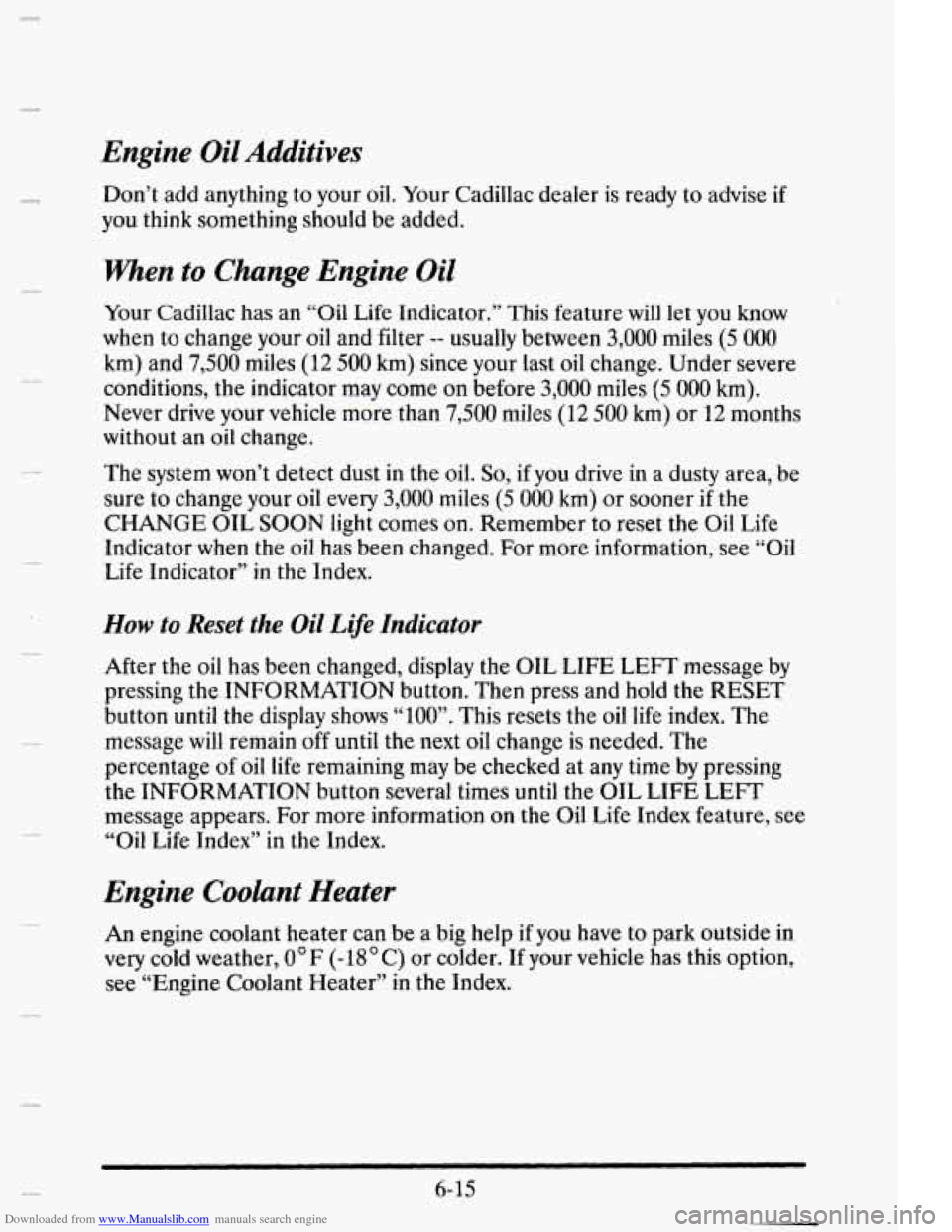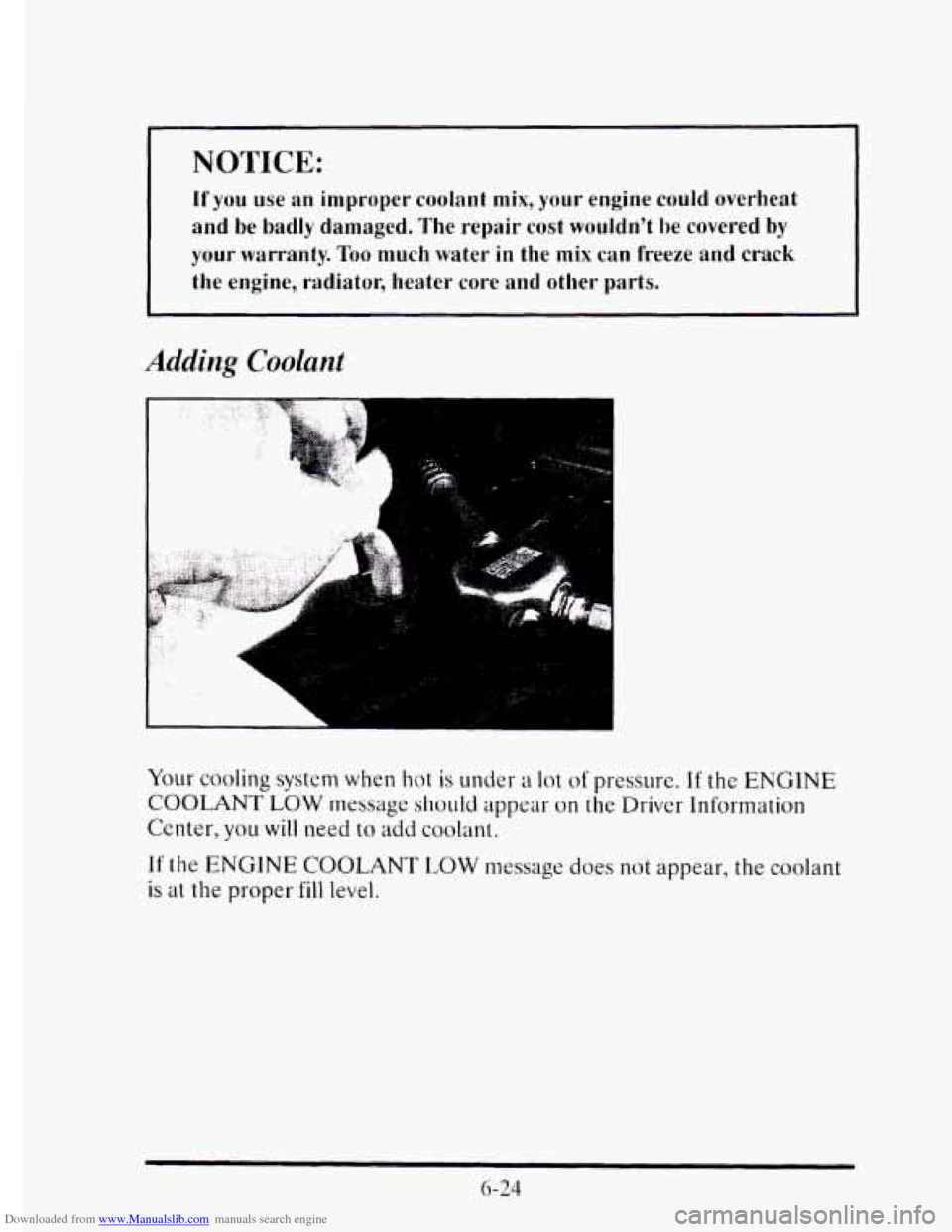1995 CADILLAC ELDORADO heater
[x] Cancel search: heaterPage 93 of 395

Downloaded from www.Manualslib.com manuals search engine ENGINE COOLANT HEATER (OPTION)
In very cold weather, 0°F (-18 ” C) or colder, the engine coolant heater
can help. You’ll get easier starting and better fuel economy during engine
warm-up. Usually, the coolant heater should be plugged
in a minimum of
four hours prior to starting your vehicle.
To use the coolant heater:
1. Turn off the engine.
2. Open the hood and unwrap the electrical cord.
3. Plug it into a normal, grounded 110-volt outlet.
NOTICE:
After you’ve used the coolant heater, be sure to store the cord as
it was before to keep it away from moving engine parts. If you
don’t, it could
be damaged.
How long should you keep the coolant heater plugged in? The answer
depends on the weather, the kind
of oil you have, and some other things.
Instead of trying to list everything here,
we ask that you contact your
Cadillac dealer in the area where you’ll be parking your vehicle. The
dealer can give you the best advice for that particular area.
2-22
Page 169 of 395

Downloaded from www.Manualslib.com manuals search engine Electronic Climate Control Features
A/C PURGE
If your vehicle is sitting out on a hot day and you have it set on AUTO,
the air will first flow out the floor air ducts for a few seconds. That is
normal. This is
to expel hot air in the air ducts. As the air is cooled, the
flow will move through the
A/C outlets. If you start your vehicle with the
fan setting on
HI it will skip the A/C Purge.
COLD WEATHER PURGE
On cold days when your system is first turned on, in either the AUTO or
ECON setting, and the fan setting is not on H1, a small amount of air will
flow through the defroster duct while
the system is waiting for the engine
coolant
to warm up enough to provide hcat. This prevents your breath
from fogging your windshield.
As the coolant warms up, the blower fan
speed will gradually increase and air will
flow from the heater outlets,
with some airflow
to the windshield to prevent fogging under most normal
conditions.
MANUALLY RECIRCULATE INSIDE AIR
There may be times when you want less air from thc outside. To
recirculate the air from the insidc, in the AUTO setting, just set the
temperature
to 60" F (36" C) and adjust your fan speed.
DEFOG
Press this button to divide the air between the windshield and the heater
ducts.
This is useful when fog appears on the windshield or side glass due
to sudden rain or snowy conditions.
3-4
Page 216 of 395

Downloaded from www.Manualslib.com manuals search engine I
You can run the
engine to keep warm,
but be careful.
Run your engine only as long as
you must. This saves fuel. When you run
the engine, make it go a little faster than just idle. That is, push the
accelerator slightly. This uses less fuel for the heat that you get and it
keeps the battery charged. You
will need a well-charged battery to restart
the vehicle, and possibly
for signaling later on with your headlamps. Let
the heater run
for awhile.
Then, shut the engine off and close the window almost all the way to
preserve the heat. Start the engine again and repeat this only when you
feel really uncomfortable from the cold. But
do it as little as possible.
4-29
Page 243 of 395

Downloaded from www.Manualslib.com manuals search engine If the coolant inside the coolant surge tank is boiling, don’t do anything
else until
it cools down.
A CAUTION
The coolant level
should be visible
inside
the surge tank
once the cap
has been
removed.
If it isn’t,
you may have a leak
in the radiator hoses,
heater
hoses, radiator,
water pump or
somewhere
else in the
cooling system.
Heater and radiator hoses, and other engine parts, can be very
hot. Don’t
touch them. If you do, you can be burned.
Don’t run the engine if there
is a leak. If you run the engine, it
could lose all coolant. That could cause an engine fire, and you
could be burned. Get any leak fixed before you drive the vehicle.
I NOTICE:
Engine damage if you keep running your engine without coolant
isn’t covered
by your warranty. See “Overheated Engine
Protection Operating Mode”
in the Index.
If there seems to be no leak, with the engine on check to see if the electric
engine fans are running.
If the engine is overheating, both fans should be
running. If they aren’t, your vehicle needs service.
5-16
Page 245 of 395

Downloaded from www.Manualslib.com manuals search engine ..
A CAUTION:
Adding only plain water to your cooling system can be
dangerous. Plain water, or some other liquid like alcohol, can
boil before the proper coolant mix
will. Your vehicle’s coolant
warning system
is set for the proper coolant mix. With plain
water or the
wrong mix, your engine could get too hot but you
wouldn’t get the overheat warning. Your engine could catch
fire
and you or others could be burned. Use a 50/50 mix of clean
water and
a proper antifreeze.
NOTICE:
In cold weather, water can freeze and crack the engine, radiator,
heater core
and other parts. So use the recommended coolant.
You can be burned if you spill coolant on hot engine parts.
Coolant contains ethylene glycol and it will burn if the engine
parts
are hot enough. Don’t spill coolant on a hot engine.
5-18
Page 274 of 395

Downloaded from www.Manualslib.com manuals search engine Engine Oil Additives
c
Don’t add anything to your oil. Your Cadillac dealer is ready to advise if
you think something should be added.
When to Change Engine Oil
Your Cadillac has an “Oil Life Indicator.” This feature will let you know
when to change your oil and filter
-- usually between 3,000 miles (5 000
km) and 7,500 miles (12 500 km) since your last oil change. Under severe
conditions, the indicator may come
on before 3,000 miles (5 000 km).
Never drive your vehicle more
than 7,500 miles (12 500 km) or 12 months
without an oil change.
The system won’t detect dust in the oil.
So, if you drive in a dusty area, be
sure to change your oil every
3,000 miles (5 000 km) or sooner if the
CHANGE OIL
SOON light comes on. Remember to reset the Oil Life
Indicator when the
oil has been changed. For more information, see “Oil
Life Indicator” in the Index.
How to Reset the Oil Life Indicator
After the oil has been changed, display the OIL LIFE LEFT message by
pressing the INFORMATION button. Then press and hold the
RESET
button until the display shows “loo”. This resets the oil life index. The
message will remain off until the next
oil change is needed. The
percentage
of oil life remaining may be checked at any time by pressing
the INFORMATION button several times until the OIL LIFE LEFT
message appears. For more information on the
Oil Life Index feature, see
“Oil Life Index” in the Index.
Engine Coolant Heater
An engine coolant heater can be a big help if you have to park outside in
very cold weather, 0°F (-18OC) or colder. If your vehicle has this option,
see “Engine Coolant Heater” in the Index.
6- 15
Page 283 of 395

Downloaded from www.Manualslib.com manuals search engine If you use an improper coolant mix, your engine could overheat
and
be badly damaged. The repair cost wouldn't he covered by
your warranty. Too much water in the mix can freeze and crack
the engine, radiator, heater core and other parts.
Adding Coolant
Your cooling system when hot is under a lot of pressure. If the ENGINE
COOLANT LOW message should appear on the Driver Information
Center,
you will need to add coolant.
If the ENGINE COOLANT LOW message does not appear, the coolant
is at the proper fill level.
6-24
Page 324 of 395

Downloaded from www.Manualslib.com manuals search engine [Engine Compartment Fuse Block
~~~
E DISTR
USAGE I
INJ
IGN 1
FUEL PUMP
PCM (BAT) RTD (BAT)
F
A/C COMP
HDLPS
TURN/HAZ
DRL
DRL
HTD W/S
IGN OFF
L HDLP
LO
I R HDLP LO Ignition
Control Module
I
L HDLP HI
R HDLP HI
I
I
TRANSECS Sensing
& Diagnostic Module
Powertrain Control Module (PCM); PASS-KeymII Decode llodule
1,4,6 and 7 Fuel Injectors
2,3,5 and 8 Fuel Injectors
A/C Refrigerant Pressure Switch; Transaxle Range Switch;
Stop/BTSI/Cruise Brake Switch; Instrument Panel Cluster; Keyless
Entry Module; DiagnosticEnergy Reserve Module (Derm);
Cornering Lamps; Tbrn/Hazard Switch Assy; Chime Module;
Headlamp Switch; Twilight Sentinel/DRL Module
Fuel Pump; Oil Pressure Switch; Powertrain Control Module
Powertrain Control Module (PCM)
Road Sensing Suspension (RSS) Module
NC Compressor Clutch
Headlamp Dimmer Switch; Headlamp Relay “D” (Engine Comp.
Micro Relay Center); DRL Headlamp Relay
“E’ (with Daytime
Running Lamps); Powers C13
Stop/BTSI/Cruise Switch; Sto lamp Switch Capacitor; Anti-Slip
Regulation (ASR)S Traction 8ontrol
Hazard Flasher; Turn Flasher Relay; Turn Flasher Module
Daytime Running Lamps (Canada)
Left and Right Lo-Beam Headlamp (Canada)
Heated Windshield Control Module
Instrument Panel Cluster
Left Lo-Beam Headlamu
(PCM)
Right Lo-Beam Headlamp
Left Hi-Beam Headlamp
Right Hi-Beam Headlamp
Rear Defogger Relay; Electronic Level Control (ELC); Heated
Windshield; Heater and A/C Programmer; Cruise Control
Extended Travel Brake Switch; Powertrain Control Module (PCM); \
Cooling Fan Relays
1,2 and 3; Front and Rear Heated Oxygen Sensor
Power Steering Pressure Switch; Exhaust Gas Recirculation (EGR)
Valve; Transaxle Shift Solenoids A
& B; Evaporative Emission
Control Solenoid; Powertrain Control Module (PCM); Torque
Converter Clutch Solenoid; TCC Brake Switch
6-65